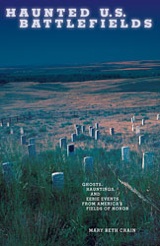Haunted U.S. Battlefields – Book Review
 Haunted U.S. Battlefields. Mary Beth Crain. Globe Pequot Press, 2008. Paperback. 197 pages. $14.95.
Haunted U.S. Battlefields. Mary Beth Crain. Globe Pequot Press, 2008. Paperback. 197 pages. $14.95.
The Alamo has produced a number of sightings, including a teenaged Mexican boy in the garb of Santa Anna’s army.
Battlefield ghosts—what better Halloween topic for history buffs? Here’s a book you can curl up with on these dark nights when wind rattling dry corn shocks sounds like a phantom army fixing bayonets.
Journalist, editor and bestselling author Mary Beth Crain collected 25 chapters worth of stories that claim unsettled spirits still walk where men once fought and died in large numbers. Most chapters contain more than one such story. The tales span conflicts from the French and Indian War to World War II. Each includes a summary of the battle, which will help educate readers unfamiliar with the events of Chadd’s Ford or Antietam.
{default}For the most part, Crain got her history right and the summaries are as accurate as any short description can be. There is one glaring historical error in the section on Chickamauga: She spends a couple of paragraphs on a headless ghost reported to be the spirit of Col. Julius Garesche whom she says was decapitated in the battle and even quotes Gen. William Hazen’s description of his burial. Actually, Garesche lost his head nine months earlier at the battle of Stones River/Murfreesboro in Tennessee, and Hazen oversaw his temporary burial there. This is an odd lapse in a book that got so much of its history right. Given the subject matter, maybe it was slipped in by a ghostwriter.
Not all the paranormal events take place on American soil, and the ghosts in the stories aren’t all American souls. The hauntings include a Scotsman who’s death at Fort Ticonderoga was foretold by his cousin’s ghost, as well as Hessian soldiers who died during the American Revolution—including one who stepped out of his portrait and chased a man from a room at the old Wayne Inn in Pennsylvania. German machine gunners still defend the Normandy beaches, and a Tiger tank continues to turn over its engine in a French woman’s back yard where it exploded.
Gettysburg is here, of course, since it is regarded as possibly the most haunted site in all America. Among its ghostly sightings is a Confederate who tries to stop tourists from taking pictures. He is believed to the unfortunate whose body was dragged to different positions on the field by Matthew Brady’s photographers.
The Alamo has produced a number of sightings, including a teenaged Mexican boy in the garb of Santa Anna’s army who befriends young visitors. At Little Bighorn, George Custer has been spotted many times, as you might expect, and numerous spirits in uniform have been reported at Pearl Harbor. A malevolent, faceless thing attacks hotel guests on Corregidor.
Surprisingly, Carnton Mansion near Franklin, Tennessee, isn’t mentioned although it claims at least five ghosts, and I’ve actually seen people run from its rooms in terror upon occasion. It served as a hospital after the 1864 battle of Franklin and has been featured in national stories and television programs.
Some people believe in ghosts, some don’t, and some want to. Whichever camp you’re in, if you can enjoy a good ghost story, this book contains some crackerjacks, and it has the added bonus of history lessons thrown in. Watch out for Garesche’s ghost this Halloween, though. For a headless guy, he seems to get around.
Gerald D. Swick is senior online editor for ArmchairGeneral.com and HistoryNet.com and writes a weekly column of Appalachian history for the Clarksburg, W.Va., The Exponent Telegram newspaper. Each Halloween he shifts the column’s focus to look at paranormal Appalachian tales in the, ah, spirit of the holiday.
ACG Intel

